Salgado Filho Porto Alegre International Airport
Porto Alegre–Salgado Filho International Airport (IATA: POA, ICAO: SBPA) is the airport serving Porto Alegre and the region of Greater Porto Alegre, Brazil. It is named after the Senator and first Minister of the Brazilian Air Force Joaquim Pedro Salgado Filho (1888–1950).
Porto Alegre–Salgado Filho International Airport Aeroporto Internacional de Porto Alegre–Salgado Filho | |||||||||||
|---|---|---|---|---|---|---|---|---|---|---|---|
 | |||||||||||
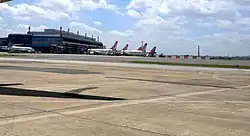 | |||||||||||
| Summary | |||||||||||
| Airport type | Public | ||||||||||
| Operator |
| ||||||||||
| Serves | Porto Alegre | ||||||||||
| Focus city for | Azul Brazilian Airlines | ||||||||||
| Time zone | BRT (UTC−03:00) | ||||||||||
| Elevation AMSL | 9 m / 30 ft | ||||||||||
| Coordinates | 29°59′41″S 051°10′16″W | ||||||||||
| Website | portoalegre-airport | ||||||||||
| Map | |||||||||||
 POA Location in Brazil | |||||||||||
| Runways | |||||||||||
| |||||||||||
| Statistics (2022) | |||||||||||
| |||||||||||
It is operated by Fraport Brasil.[5]
History
Salgado Filho was originally called São João Federal Airport, after the neighborhood where it is located. In the beginning it was an air club, where the first flights landed on May 31, 1923.
In 1932, needing a facility to use its aircraft with landing-gear which were replacing its seaplanes, Varig started using São João Airport as its operational base. However, it was only in 1940 that the first passenger terminal was commissioned.[6]
On October 12, 1951, São João Federal Airport was renamed Salgado Filho Airport, after the Senator and Minister who died the year before in a crash involving a SAVAG aircraft that departed from Porto Alegre.
On July 21, 1953, within a law prescribing rules for the naming of airports, the name of the facility was officially and exceptionally maintained as Salgado Filho Airport.[7]
In 1953, the old terminal was incorporated into the maintenance facilities of Varig, a new passenger terminal was opened, and runways were paved.[6] Until that year, larger aircraft such as Lockheed L-049 Constellations had to land at Canoas Air Force Base.[8] This new terminal is known today as Passenger Terminal 2. It underwent major renovations and enlargements between 1969 and 1971; but unable to cope with the increasing traffic, another brand new facility was built. This new facility was named Passenger Terminal 1 and opened on September 11, 2001. Terminal 2 became underused by general aviation and cargo services.
However, in order to cope with the increasing passenger traffic at the airport, on September 8, 2010 , a decision was made to renovate Terminal 2 and bring it back into passenger use.[9] It became operational on December 4, 2010.[10] This terminal 2 was again closed for air traffic on September 15, 2019, and it became the administration center of Fraport Brasil S.A.- Aeroporto de Porto Alegre.[11]
Responding to critiques to the situation of its airports, on May 18, 2011, Infraero released a list evaluating some of its most important airports according to its saturation levels. According to the list, Porto Alegre was considered to be in good situation, operating with less than 70% of its capacity.[12]
Previously operated by Infraero, in January 2018, the airport's operations and administration were taken over by the German private airport operator Fraport, which in the previous year had been the winning bidder in an B3 (stock exchange) auction conducted by the Brazilian government for the concession of the airport for 25 years.[13][14] Since the airport concession, Fraport has been expanding the runway from the current 2,280 meters (7,481 ft) to 3,200 meters (10,499 ft), allowing the landing of large aircraft and allowing the landing of flights from North America and Europe. It is expected that the expansion works will be concluded at the end of 2021.[15]
The total area of the Salgado Filho Airport is about 3,805,810 square metres (40,965,400 sq ft) (940 acres) with 14,750 square metres (158,800 sq ft) of ramp area. Terminal 1 has 37,600 square metres (405,000 sq ft) and 16 gates with jetways. Terminal 2 has 15,540 square metres (167,300 sq ft). In front of Terminal 1 there is a carpark with 1,440 places. Terminal 1 is the first facility in Latin America with a shopping mall.
One of the two TAP Maintenance & Engineering centers in Brazil is located at Salgado Filho International Airport.
As of May 2022, the airport's expanded 3,200 m (10,499 ft) runway has come into operation. With the runway expansion, larger aircraft such as the Boeing 747-400, Boeing 777-300 and Airbus 330-900 can operate at the airport, allowing direct flights to Europe and the United States.[16]
Airlines and destinations
Passenger
Note:
a: Flights operated with Voepass equipment on behalf of LATAM Brasil.
Cargo
| Airlines | Destinations |
|---|---|
| Azul Brazilian Airlines | Campinas, São Paulo–Guarulhos |
| Total Linhas Aéreas | São Paulo-Guarulhos |
Ground transportation
The airport is located 9 km (6 mi) from downtown Porto Alegre.
Since August 10, 2013, the Metro-Airport Connection people mover connects the International Airport to the Porto Alegre Metro Airport Station.[17] From this metro station one can reach most cities of the metropolitan area of Porto Alegre. Bus routes T5, T11, and B09 link Terminal 1 - International Airport to the city of Porto Alegre.
Accidents and incidents
- February 28, 1942: a Varig Junkers Ju 52/3m registration PP-VAL crashed shortly after take-off from Porto Alegre. Seven of the 23 occupants died, including 2 crew members.[18][19]
- June 20, 1944: a Varig Lockheed 10 A/E Electra registration PP-VAQ on approach to Porto Alegre after a flight from Pelotas during a storm crashed on the waters of Guaíba river. All 10 passengers and crew died.[20][21]
- August 2, 1949: a Varig Curtiss C-46AD-10-CU Commando registration PP-VBI operating a flight from São Paulo-Congonhas Airport to Porto Alegre made an emergency landing on rough terrain near the location of Jaquirana, approximately 20 minutes before landing in Porto Alegre, following fire on the cargo hold. Of the 36 passenger and crew aboard, 5 died.[22][23]
- June 30, 1950: a SAVAG Lockheed Model 18 Lodestar registration PP-SAA, flying from Porto Alegre to São Borja in bad weather collided against a hill, caught fire and crashed near the location of São Francisco de Assis. All 10 occupants died, including the founder of SAVAG and pilot, Gustavo Kraemer, and Joaquim Pedro Salgado Filho, senator and first Minister of Air Force in Brazil.[24][25]
- October 14, 1952: an Aerovias Brasil Douglas C-47-DL registration PP-AXJ operated by Real Transportes Aéreos en route from São Paulo-Congonhas to Porto Alegre struck high ground while flying under adverse conditions over the location of São Francisco de Paula. Of the 18 passengers and crew aboard, 14 died.[26][27]
- October 18, 1957: a Varig Douglas C-47A-80-DL registration PP-VCS operating a cargo flight from Porto Alegre crashed upon take-off. The crew of two died.[28]
- May 30, 1972: a Varig Lockheed L-188 Electra registration PP-VJL operating a flight between São Paulo-Congonhas to Porto Alegre was hijacked. The hijacker demanded money. The aircraft was stormed and the hijacker shot.[29]
Gallery
 Terminal 1 interior
Terminal 1 interior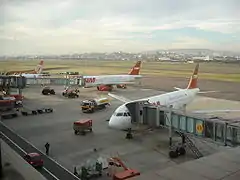 LATAM Brasil, formerly TAM and GOL airliners
LATAM Brasil, formerly TAM and GOL airliners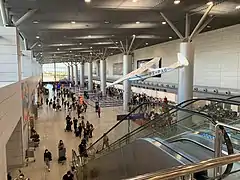 Check-in area
Check-in area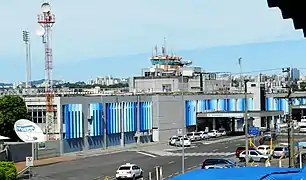 Former terminal 2
Former terminal 2 Mural on former terminal 2
Mural on former terminal 2 Terminal 1 seen from parking during sunset
Terminal 1 seen from parking during sunset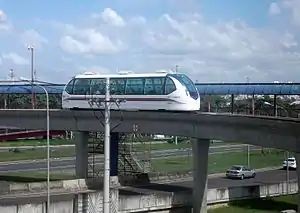
See also
References
- "Movimentação Aeroportuária". Porto Alegre Airport (in Portuguese). Retrieved 25 May 2023.
- "Porto Alegre Airport". Fraport. Retrieved 5 May 2022.
- "Aeródromos". ANAC (in Portuguese). 29 June 2020. Retrieved 19 April 2021.
- "Salgado Filho (SBPA)". DECEA (in Portuguese). Retrieved 25 September 2023.
- Farina, Erik (16 March 2017). "Grupo alemão vence leilão e assume aeroporto Salgado Filho por 25 anos". GZH (in Brazilian Portuguese). Retrieved 26 July 2021.
- Beting, Gianfranco; Beting, Joelmir (2009). Varig: Eterna Pioneira (in Portuguese). Porto Alegre and São Paulo: EDIPUCRS and Beting Books. p. 35. ISBN 978-85-7430-901-9.
- "Lei no 1.909, de 21 de julho de 1953". Presidência da República (in Portuguese). 21 July 1953. Retrieved 15 October 2023.
- Germano da Silva, Carlos Ari César (2008). "Está faltando um". O rastro da bruxa: história da aviação comercial brasileira no século XX através dos seus acidentes 1928-1996 (in Portuguese) (2 ed.). Porto Alegre: EDIPUCRS. p. 96. ISBN 978-85-7430-760-2.
- "Reformulação do antigo terminal do Aeroporto Salgado Filho é antecipada" (in Portuguese). Zero Hora. September 8, 2010. Archived from the original on July 22, 2012. Retrieved September 15, 2010.
- Andrade, Artur Luiz (December 1, 2010). "Webjet utiliza terminal 2 do Salgado Filho (RS)" (in Portuguese). Panrotas. Archived from the original on July 6, 2011. Retrieved December 1, 2010.
- "Porto Alegre Airport concentra operações de todas as companhias aéreas em um só Terminal" (PDF). Porto Alegre Airport (in Portuguese). 4 September 2019. Retrieved 17 September 2019.
- "Governo muda critério de avaliação e 'melhora' desempenho de aeroportos" (in Portuguese). O Estado de S. Paulo. 19 May 2011. Retrieved 20 May 2011.
- "Aeroporto Internacional - Porto Alegre - RS" [International Airport - Porto Alegre - RS] (in Portuguese). Infraero. Archived from the original on 2018-03-23. Retrieved 2018-03-23.
- "Fraport - Porto Alegre Airport". Fraport Porto Alegre. Archived from the original on 2018-03-23. Retrieved 2018-03-23.
- "Prefeitura de Porto Alegre deve agilizar remoção de famílias da Vila Nazaré". Correio do Povo (in Brazilian Portuguese). Retrieved 21 April 2021.
- Oliveira, Bruna (19 May 2022). "No aguardo das grandes aeronaves, expectativa é impulsionar exportações após ampliação da pista do aeroporto de Porto Alegre". GZH (in Brazilian Portuguese). Retrieved 20 May 2022.
- "G1 - Com a presença de Dilma, aeromóvel é inaugurado em Porto Alegre - notícias em Rio Grande do Sul". Rio Grande do Sul. 10 August 2013. Archived from the original on 2013-08-13. Retrieved 2013-08-18.
- Pereira, Aldo (1987). Breve História da Aviação Comercial Brasileira (in Portuguese). Rio de Janeiro: Europa. p. 75.
- Germano da Silva, Carlos Ari César (2008). "Verão de 1942". O rastro da bruxa: história da aviação comercial brasileira no século XX através dos seus acidentes 1928-1996 (in Portuguese) (2 ed.). Porto Alegre: EDIPUCRS. pp. 42–48. ISBN 978-85-7430-760-2.
- Pereira, Aldo (1987). Breve História da Aviação Comercial Brasileira (in Portuguese). Rio de Janeiro: Europa. p. 76.
- Germano da Silva, Carlos Ari César (2008). "O Electra e o temporal". O rastro da bruxa: história da aviação comercial brasileira no século XX através dos seus acidentes 1928-1996 (in Portuguese) (2 ed.). Porto Alegre: EDIPUCRS. pp. 61–65. ISBN 978-85-7430-760-2.
- "Accident description PP-VBI". Aviation Safety Network. Archived from the original on November 4, 2012. Retrieved August 15, 2011.
- Germano da Silva, Carlos Ari César (2008). "Fogo a bordo". O rastro da bruxa: história da aviação comercial brasileira no século XX através dos seus acidentes 1928-1996 (in Portuguese) (2 ed.). Porto Alegre: EDIPUCRS. pp. 83–86. ISBN 978-85-7430-760-2.
- "Accident description PP-SAA". Aviation Safety Network. Archived from the original on January 28, 2012. Retrieved August 15, 2011.
- Germano da Silva, Carlos Ari César (2008). "Salgado Filho". O rastro da bruxa: história da aviação comercial brasileira no século XX através dos seus acidentes 1928-1996 (in Portuguese) (2 ed.). Porto Alegre: EDIPUCRS. pp. 102–107. ISBN 978-85-7430-760-2.
- "Accident description PP-AXJ". Aviation Safety Network. Archived from the original on November 4, 2012. Retrieved August 16, 2011.
- Germano da Silva, Carlos Ari César (2008). "Erro de navegação". O rastro da bruxa: história da aviação comercial brasileira no século XX através dos seus acidentes 1928-1996 (in Portuguese) (2 ed.). Porto Alegre: EDIPUCRS. pp. 112–117. ISBN 978-85-7430-760-2.
- "Accident description PP-VCS". Aviation Safety Network. Archived from the original on November 4, 2012. Retrieved August 16, 2011.
- "Incident description PP-VJL". Aviation Safety Network. Archived from the original on November 4, 2012. Retrieved August 16, 2011.
![]() This article incorporates public domain material from the Air Force Historical Research Agency.
This article incorporates public domain material from the Air Force Historical Research Agency.
External links
![]() Media related to Salgado Filho International Airport at Wikimedia Commons
Media related to Salgado Filho International Airport at Wikimedia Commons
- Airport information for SBPA at Great Circle Mapper. Source: DAFIF (effective October 2006).
- Current weather for SBPA at NOAA/NWS
- Accident history for POA at Aviation Safety Network